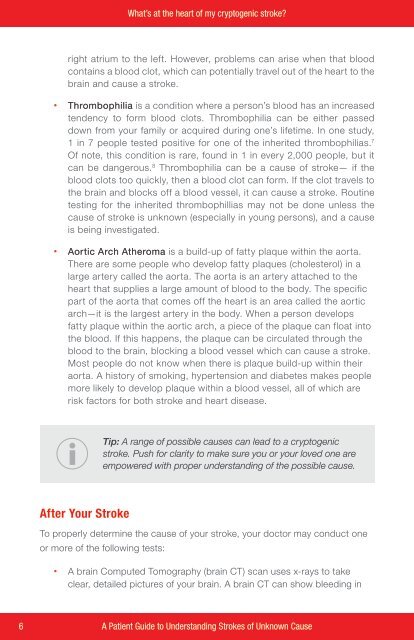my cryptogenic stroke?
6018BKb2Y
6018BKb2Y
- No tags were found...
Create successful ePaper yourself
Turn your PDF publications into a flip-book with our unique Google optimized e-Paper software.
What’s at the heart of <strong>my</strong> <strong>cryptogenic</strong> <strong>stroke</strong>?<br />
What’s at the heart of <strong>my</strong> <strong>cryptogenic</strong> <strong>stroke</strong>?<br />
∙∙<br />
∙∙<br />
right atrium to the left. However, problems can arise when that blood<br />
contains a blood clot, which can potentially travel out of the heart to the<br />
brain and cause a <strong>stroke</strong>.<br />
Thrombophilia is a condition where a person’s blood has an increased<br />
tendency to form blood clots. Thrombophilia can be either passed<br />
down from your family or acquired during one’s lifetime. In one study,<br />
1 in 7 people tested positive for one of the inherited thrombophilias. 7<br />
Of note, this condition is rare, found in 1 in every 2,000 people, but it<br />
can be dangerous. 8 Thrombophilia can be a cause of <strong>stroke</strong>— if the<br />
blood clots too quickly, then a blood clot can form. If the clot travels to<br />
the brain and blocks off a blood vessel, it can cause a <strong>stroke</strong>. Routine<br />
testing for the inherited thrombophillias may not be done unless the<br />
cause of <strong>stroke</strong> is unknown (especially in young persons), and a cause<br />
is being investigated.<br />
Aortic Arch Atheroma is a build-up of fatty plaque within the aorta.<br />
There are some people who develop fatty plaques (cholesterol) in a<br />
large artery called the aorta. The aorta is an artery attached to the<br />
heart that supplies a large amount of blood to the body. The specific<br />
part of the aorta that comes off the heart is an area called the aortic<br />
arch—it is the largest artery in the body. When a person develops<br />
fatty plaque within the aortic arch, a piece of the plaque can float into<br />
the blood. If this happens, the plaque can be circulated through the<br />
blood to the brain, blocking a blood vessel which can cause a <strong>stroke</strong>.<br />
Most people do not know when there is plaque build-up within their<br />
aorta. A history of smoking, hypertension and diabetes makes people<br />
more likely to develop plaque within a blood vessel, all of which are<br />
risk factors for both <strong>stroke</strong> and heart disease.<br />
∙∙<br />
∙∙<br />
the brain or damage to brain cells from a <strong>stroke</strong>.<br />
Magnetic Resonance Imaging (MRI) uses magnets and radio waves to<br />
create a picture of the organs and structures in your body. This test can<br />
detect changes in brain tissue and damage to brain cells from a <strong>stroke</strong>.<br />
An MRI may be used instead of, or in addition to, a CT scan to diagnose<br />
a <strong>stroke</strong>.<br />
Blood tests that check for blood glucose levels, blood and platelet<br />
counts, electrolyte levels and renal tests, and cardiac ischemic, among<br />
other health factors.<br />
∙∙<br />
A blood glucose test measures the amount of glucose (sugar) in<br />
your blood. Low blood glucose levels may cause symptoms similar<br />
to those of a <strong>stroke</strong>.<br />
∙∙<br />
A platelet count measures the number of platelets in your blood.<br />
Blood platelets are cell fragments that help your blood clot.<br />
Abnormal platelet levels may be a sign of a bleeding disorder (not<br />
enough clotting) or a thrombotic disorder (too much clotting).<br />
∙∙<br />
Activated Partial Thromboplastin Time (aPTT or APTT) measures<br />
the time it takes your blood to clot.<br />
∙∙<br />
Prothrombin Time (PT) measures how long it takes blood to clot.<br />
It also is used to check whether medicine to prevent blood clots<br />
is working.<br />
∙∙<br />
International Normalized Ratio (INR) tests how well your blood<br />
can form clots. Since a clot in the vessel of the brain is a common<br />
cause of <strong>stroke</strong>, this test will help your physician determine if you<br />
need anti-clotting medication.<br />
After Your Stroke<br />
To properly determine the cause of your <strong>stroke</strong>, your doctor may conduct one<br />
or more of the following tests:<br />
∙∙<br />
Tip: A range of possible causes can lead to a <strong>cryptogenic</strong><br />
<strong>stroke</strong>. Push for clarity to make sure you or your loved one are<br />
empowered with proper understanding of the possible cause.<br />
A brain Computed Tomography (brain CT) scan uses x-rays to take<br />
clear, detailed pictures of your brain. A brain CT can show bleeding in<br />
∙∙<br />
∙∙<br />
Oxygen saturation – Your red blood cells carry oxygen through your<br />
arteries to all of your internal organs. They must carry enough oxygen to<br />
keep you alive. Normally, when red blood cells pass through the lungs,<br />
95-100 percent of them are loaded with oxygen. If you have a medical<br />
condition, your oxygen saturation might be lower than 95 percent. An<br />
oxygen saturation test is painless and is measured by using a clip that<br />
fits on your finger.<br />
Heart rhythm monitoring may be administered in-hospital or at home<br />
to help identify the cause of the <strong>stroke</strong> and guide <strong>stroke</strong> prevention<br />
strategies. A heart rhythm device records heart rhythm over both short<br />
and long periods of time. Heart rhythm monitoring is ordered if your<br />
physician suspects AFib as a possible cause of a <strong>stroke</strong>, including:<br />
6 A Patient Guide to Understanding Strokes of Unknown Cause<br />
A Patient Guide to Understanding Strokes of Undetermined Cause<br />
7


